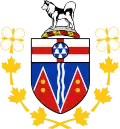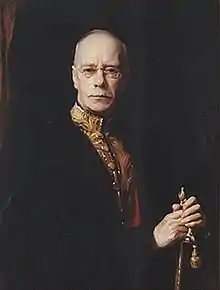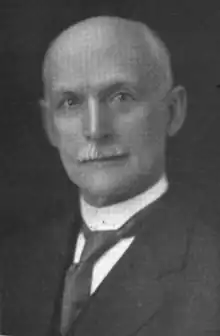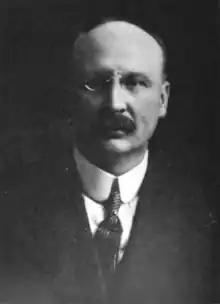Commissioner of Yukon
The commissioner of Yukon (French: Commissaire du Yukon) is the representative of the Government of Canada in the Canadian federal territory of Yukon. The commissioner is appointed by the federal government and, in contrast to the governor general of Canada or the lieutenant governors of the Canadian provinces, is not a viceroy and therefore not a direct representative of the Canadian monarch in the territory eo ipso.
| Commissioner of Yukon | |
|---|---|
| Commissaire du Yukon | |
 Badge of the Commissioner of Yukon | |
 Flag of the Commissioner of Yukon | |
| Style | The Honourable |
| Inaugural holder | James Morrow Walsh |
| Formation | August 17, 1897 |
| Website | commissionerofyukon |
List of commissioners
Commissioners (1894–1918)
Before the Yukon became a Territory on June 13, 1898, the Dominion agent/gold commissioner (Constantine and Fawcett) and the chief executive officer of the Yukon (Walsh for the first part of his term) was the Yukon representative.
| No. | Image | Commissioner | Term start | Term end |
|---|---|---|---|---|
| 1 | Inspector Charles Constantine | May 26, 1894 | May 27, 1897 | |
| 2 | Thomas Fawcett | May 27, 1897 | August 17, 1897 | |
| 3 |  |
James Morrow Walsh | August 17, 1897 | July 4, 1898 |
| 4 | .jpg.webp) |
William Ogilvie | July 4, 1898 | March 11, 1901 |
| 5 |  |
James Hamilton Ross | March 11, 1901 | October 16, 1902 |
| 6 |  |
Henry William Newlands (Acting) | February 8, 1902 | August 15, 1902 |
| 7 | .jpg.webp) |
Zachary Taylor Wood (Acting) | August 15, 1902 | March 4, 1903 |
| 8 |  |
Frederick Tennyson Congdon | March 4, 1903 | October 27, 1904 |
| 9 | .jpg.webp) |
Zachary Taylor Wood (Acting) | October 29, 1904 | May 27, 1905 |
| 10 |  |
William Wallace Burns McInnes | May 27, 1905 | December 31, 1906 |
| 11 | John T. Lithgow (Acting) | December 31, 1906 | June 17, 1907 | |
| 12 |  |
Alexander Henderson | June 17, 1907 | June 1, 1911 |
| 13 | Arthur Wilson (Administrator) | June 1, 1911 | February 1, 1912 | |
| 14 |  |
George Black | February 1, 1912 | April 1, 1918 |
| 15 | George Norris Williams (Administrator while Black fought in WWI) | October 13, 1916 | April 1, 1918 |
Gold commissioners
The offices of Commissioner and Administrator were abolished in 1918. Office replaced by the Gold Commissioner who was responsible to the federal Minister of the Interior (and since 1936 the Minister of Mines and Resources). Gosselin was not a Commissioner
| No. | Gold Commissioner | Term start | Term end |
|---|---|---|---|
| 16 | George P. MacKenzie | April 1, 1918 | November 16, 1924 |
| 17 | Percy Reid | November 17, 1924 | November 14, 1927 |
| 18 | George A. Jeckell (Acting) | November 14, 1927 | September 10, 1928 |
| 19 | George I. MacLean | September 10, 1928 | June 30, 1932 |
Comptrollers
The positions of Gold Commissioner and Comptroller were combined in 1932 with the Comptroller being the title for the chief executive. The title was changed to "Controller" in 1936.
| No. | Controller | Term start | Term end |
|---|---|---|---|
| 20 | George A. Jeckell Comptroller (1932–36) Controller (1936–47) | June 30, 1932 | September 20, 1947 |
| 21 | John Edward Gibben | September 20, 1947 | July 12, 1948 |
Commissioners (1948–present)
In 1948, the title of chief executive once again became Commissioner. By the 1960s, the Commissioner had formed an executive committee that included some members of the elected Territorial Council, in essence a cabinet. (By the mid-1970s, the Territorial Council was referring to itself as a Legislative Assembly, and its members MLAs rather than Councillors.) Beginning in 1978, Yukon had party government with a Government Leader.
In October 1979, federal minister Jake Epp (Indian Affairs and Northern Development) issued a letter, often known as the Epp letter, instructing the Commissioner to assume a role similar to that of a provincial Lieutenant-Governor, and devolving leadership of the day-to-day government to the majority leader of the legislative assembly (territorial council), to whom the Epp letter granted the authority to use the title Premier. At that time, the government leader added a fifth elected member to the committee, which became an executive council.
Subsequent federal ministers did not revoke this authority and instruction, which was eventually codified in amendments to the Yukon Act, along with redesignation of the legislative assembly from territorial council. The process, particularly since 1979, has devolved powers from the federal government to the territorial government, bringing authority which is normally reserved by the Articles of Confederation for provinces to the territory.
| No. | Commissioner | Term start | Term end |
|---|---|---|---|
| 21 | John Edward Gibben | July 13, 1948 | August 15, 1950 |
| 22 | Andrew Harold Gibson | August 15, 1950 | October 15, 1951 |
| 23 | Frederick Fraser | October 15, 1951 | November 15, 1952 |
| 24 | Wilfred George Brown | November 15, 1952 | June 8, 1955 |
| 25 | Frederick Howard Collins | June 8, 1955 | May 1, 1962 |
| 26 | Gordon Robertson Cameron | May 1, 1962 | November 7, 1966 |
| 27 | James Smith | November 7, 1966 | July 1, 1976 |
| 28 | Arthur MacDonald Pearson | July 1, 1976 | October 31, 1978 |
| 29 | Frank Fingland | October 31, 1978 | January 19, 1979 |
| 30 | Ione Christensen | January 20, 1979 | October 9, 1979 |
| 31 | Douglas Bell | October 9, 1979 | March 27, 1986 |
| 32 | Ken McKinnon | March 27, 1986 | June 11, 1995 |
| 33 | Judy Gingell | June 12, 1995 | September 30, 2000 |
| 34 | Jack Cable | October 1, 2000 | November 30, 2005 |
| 35 | Geraldine Van Bibber | December 1, 2005 | December 16, 2010 |
| 36 | Doug Phillips | December 17, 2010 | January 31, 2018[1] |
| 37 | Angélique Bernard | March 12, 2018[2] | May 31, 2023 |
| 38 | Adeline Webber | May 31, 2023 | Incumbent |
References
- "History". Commissioner of Yukon. Government of Yukon. Retrieved November 30, 2009.
- "Commissioners of the Yukon Territory". The Canadian Encyclopedia. Retrieved September 5, 2018.
- Specific